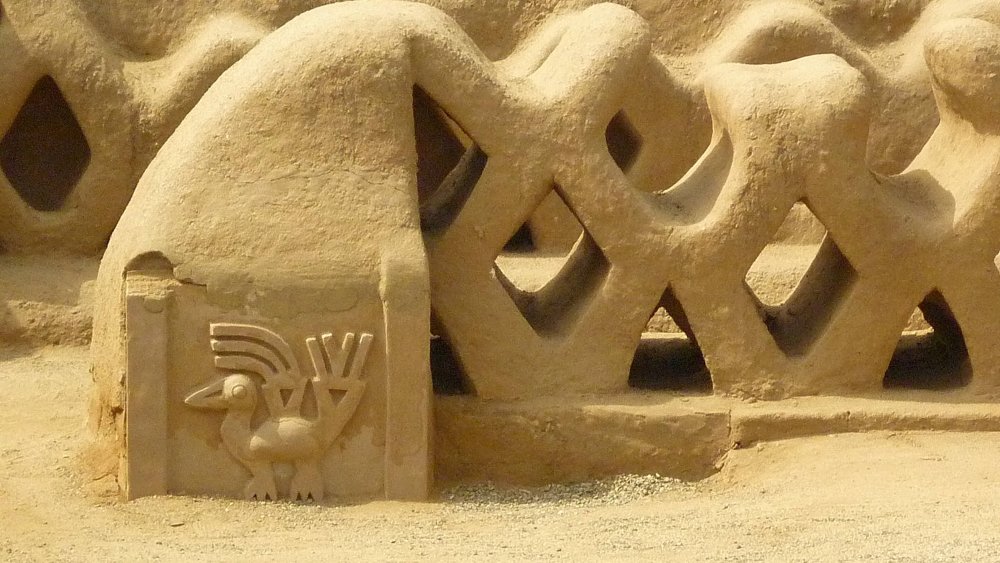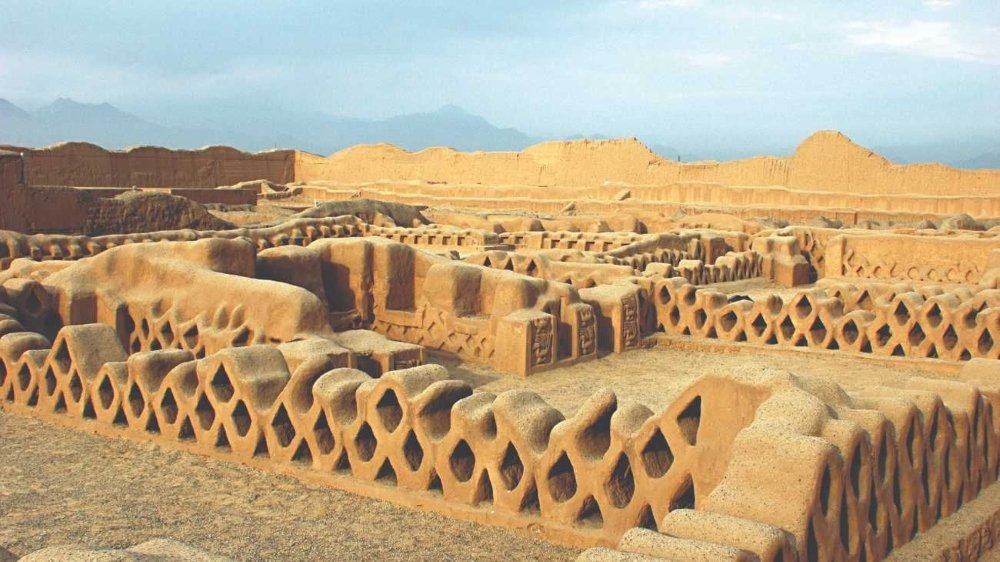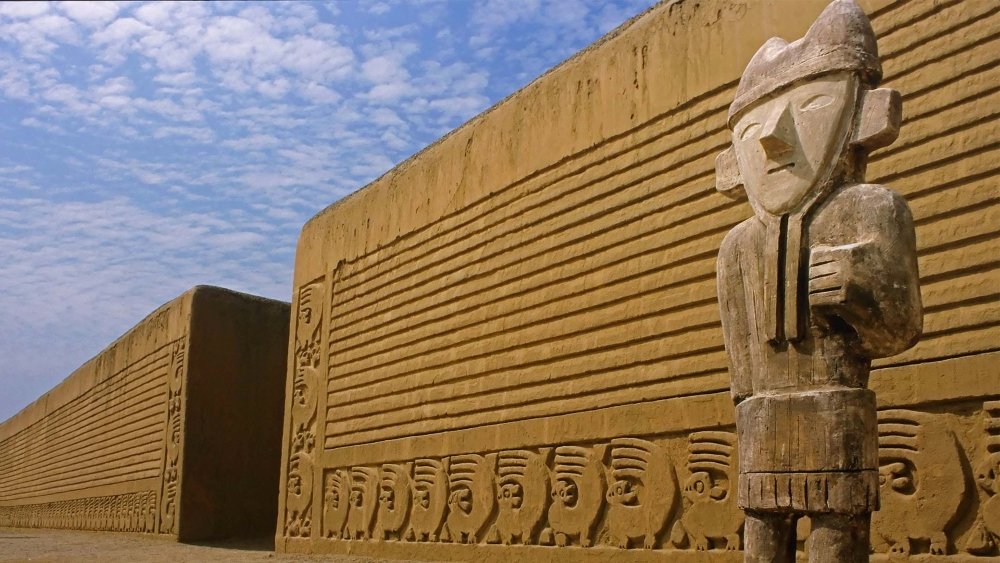Chan Chan Archaeological Centre
The Chan Chan Archaeological Centre is a historical and archaeological site located in the region of La Libertad, in northern Peru. It is famous for being the largest mud-brick citadel in pre-Columbian America and was the capital of the Chimú Kingdom, which flourished between the 9th and 15th centuries AD.
Chan Chan is renowned for its impressive adobe architecture, with huge walls decorated with geometric reliefs and zoomorphic figures. The archaeological site covers an extensive area and is composed of several citadels (each with its own palace and administrative structures) connected by streets and squares.
History of the Chan Chan Archaeological Centre
The Archaeological Site of Chan Chan has a fascinating history dating back to the pre-Columbian period on the northern coast of Peru. Here’s a summary of its history:
Foundation and development under the Chimú Kingdom (900-1470 AD):
- Chan Chan was the capital of the Chimú Kingdom, a pre-Inca civilization that flourished between the 9th and 15th centuries AD.
- It was founded around 900 AD by the first ruler of the Chimú, Tacaynamo.
Expansion and peak:
- During its peak, Chan Chan was one of the largest and most advanced cities in South America.
- It is estimated to have housed tens of thousands of inhabitants and was primarily dedicated to administrative, ceremonial, and commercial activities.
Architecture and urban design:
- The citadel of Chan Chan consists of nine large walled complexes, called citadels, each with its own complex of courtyards, plazas, storerooms, and temples.
- The walls are decorated with friezes featuring geometric motifs, zoomorphic figures, and stylized designs reflecting Chimú iconography and cosmology.
Decline and Inca conquest (1470 AD):
- In 1470 AD, Chan Chan was conquered by the Inca Empire under Emperor Pachacuti.
- The Incas incorporated the Chimú territory into their empire, though the Chimú retained some cultural and administrative autonomy in the region.
Colonial era and abandonment:
- With the arrival of the Spanish in the 16th century, Chan Chan was gradually abandoned due to disruption caused by conquest and colonization.
- Many remaining inhabitants relocated elsewhere, and the citadel was left in ruins buried under desert sands.
Rediscovery and conservation:
- In the late 19th and early 20th centuries, Chan Chan began to be studied by archaeologists and explorers.
- In 1986, it was declared a UNESCO World Heritage Site due to its cultural and architectural significance.
- Today, Chan Chan is one of Peru’s most important and visited archaeological sites, attracting tourists and scholars from around the world.
In summary, the Archaeological Site of Chan Chan stands as an impressive testament to the Chimú civilization’s ability to construct and organize a monumental city amidst the arid coastal landscape of northern Peru.

What do we find in Chan Cha?
Here’s the information about Chan Chan in English:
In Chan Chan, the largest adobe city in the world and the capital of the Chimú Kingdom, visitors can explore a variety of structures and elements that reflect the rich culture and social organization of this ancient civilization. Here are some of the main features and findings at Chan Chan:
- Walled citadels:
Chan Chan is divided into nine walled citadels, each with its own complex of courtyards, plazas, and buildings. These citadels are constructed from adobe and are notable for their large walls adorned with geometric reliefs and zoomorphic figures.
- Palaces and administrative complexes:
Within each citadel are structures that likely served as palaces for rulers or administrative complexes. These spaces include rooms, storage areas, and ceremonial spaces.
-
Decorative friezes:
Many buildings in Chan Chan feature walls decorated with friezes displaying geometric designs, stylized figures of seabirds, fish, and other animals. These friezes served not only decorative purposes but also likely held symbolic and religious meanings.
- Water systems:
Chan Chan shows evidence of canal systems and water storage facilities, indicating advanced urban planning to manage water resources in a semi-arid environment.
- Cemeteries and burials:
Outside the citadels, archaeologists have found cemeteries and graves that provide insights into funerary practices and the social structure of the Chimú society.
- Objects and artifacts:
Excavations at Chan Chan have uncovered a variety of objects and artifacts, including ceramics, textiles, metal tools, and ritual objects, shedding light on daily life and cultural practices of the time.
- Murals:
Some areas of Chan Chan have revealed remnants of murals, albeit heavily deteriorated, offering clues about the ornamentation and visual symbolism used by the Chimú.
- Restoration and conservation:
Since its discovery, Chan Chan has undergone restoration and conservation efforts to protect its vulnerable structures and enable ongoing study by archaeologists and visitors.
In summary, Chan Chan is an archaeological treasure that provides a fascinating glimpse into the Chimú culture and their sophisticated pre-Columbian civilization. Each aspect of the site offers valuable insights into how the ancient inhabitants of this region in Peru lived, worked, and worshipped.













